WOW Cart Collaborations & Demonstrations
EPA's partnership with WaterStep invites collaborations across sectors to challenge application of the Water-on-Wheels Mobile Emergency Water Treatment System (WOW Cart). Public-private partnerships bring EPA researchers and experts in academia and industry together to help communities solve real environmental problems.
Below are examples of partner collaborations and demonstrations of the WOW Cart. Also check out examples of emergency deployments.
On this page:
Collaborations with U.S. Army Corps of Engineers
Relief Well Rehabilitation
There are tens of thousands of relief wells located along the levees and dams in the United States designed to relieve water pressure on those critical infrastructures. These wells can become encrusted with corrosion and biofilm, reducing their flow production and ability to reduce pressures, thus putting the network of dams and levees at risk for failure.
The United States Army Corps of Engineers (USACE) treats each well to clear the corrosion and biofilm. USACE typically treats the wells every 3-5 years with the goal of reducing the time between treatments. The USACE mixes bags of oxalic acid with well water in a 1,000-gallon tank and reinjects the solution into the well. The acid solution is left in the well overnight and then the well is flushed with air to remove and flush out the corrosion and biofilm. The tank, pumps, and acid are transported to the relief well site and operations are conducted from a trailer.
The USACE investigated the WOW Cart, in collaboration with EPA and WaterStep, as a replacement for the oxalic acid flushing to:
- Improve the rehabilitation of the wells
- Increase the number of wells that can be treated in a day
- Reduce the cost
- Improve the safety of the well rehabilitation procedures
WOW Carts were deployed in 2022 and 2023 to two treatment sites in Mississippi for this study.
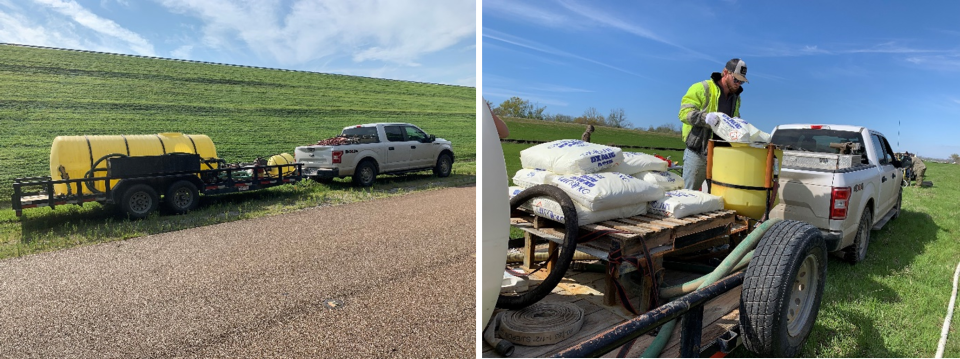
August 2022 - Granada Lake, MS
Granada Lake is located northeast of the City of Granada on the Yalobusha River, which is a tributary of the Mississippi River. Over 130,000 homes were lost and 700,000 people displaced during the disastrous Mississippi River flood in the winter of 1926-1927. The disastrous flood of 1927 served as the catalyst for the construction of four strategically located reservoirs located in North Mississippi. The earthen-filled Granada Lake Dam was completed in 1954 and stands 80 feet above the streambed. There are 120 relief wells in the toe below the dam that is 2.6 miles long.
The Granada Lake Dam relief wells flow continuously, which requires the treatment solutions to be pumped into the wells, then capped to treat the well casings overnight before injecting air into the ground to remove any contaminants, also known as air sparging. USACE evaluated the oxalic acid treatment against the WOW Cart treatment train, which includes filtration and chlorine gas injection. Another treatment alternative is directly injecting the chlorine bleach solution only (generated by the BleachMaker, a component of the WOW Cart that produces a chlorine bleach solution), that can be produced in parallel to the water treatment train from the WOW Cart.
-
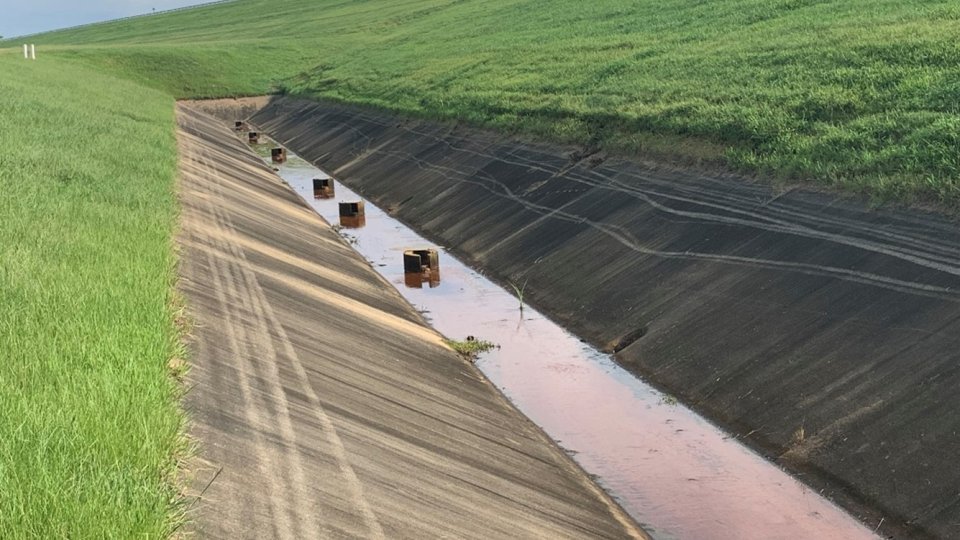
Relief wells at the Granada Lake Dam.
-
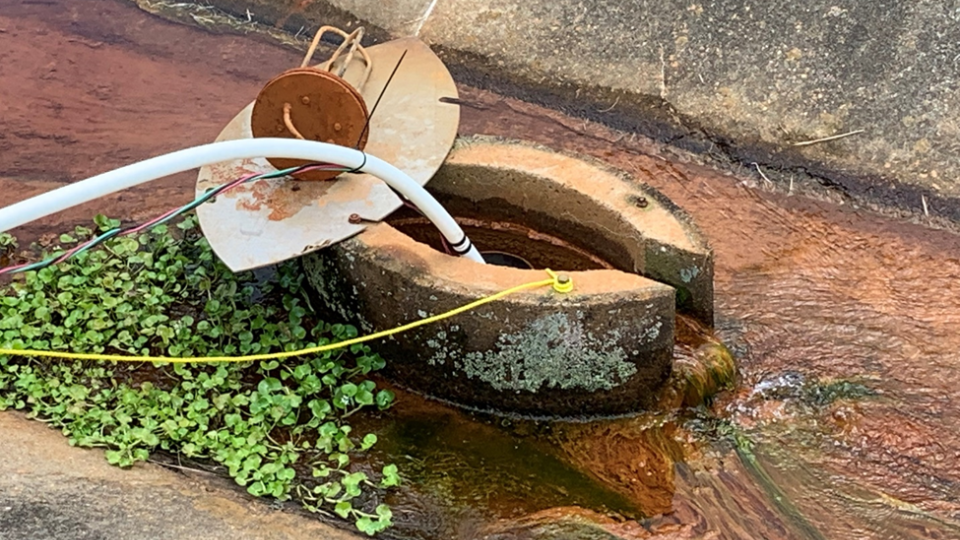
Treated water produced by the WOW Cart is pumped into a Granada Lake Dam relief well.
-
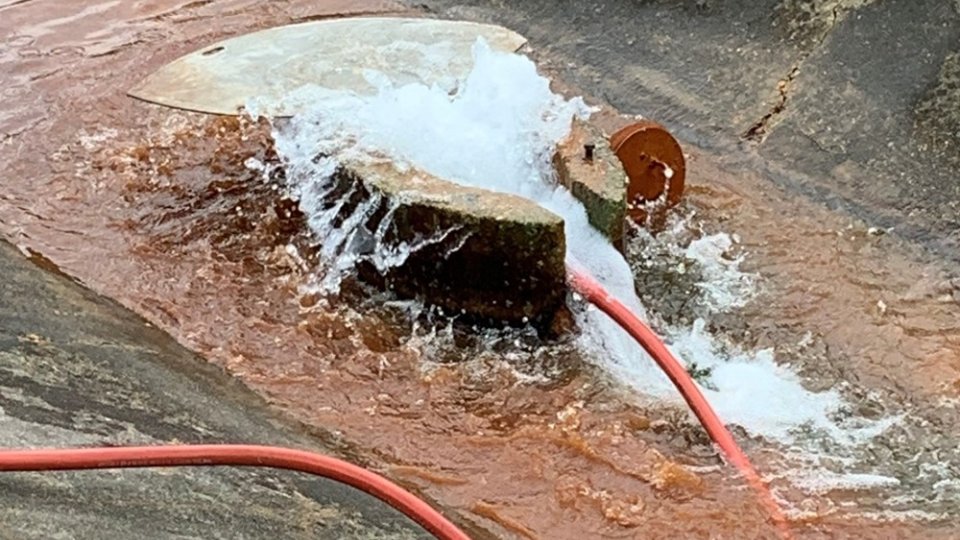
Air sparging of a Granada Lake Dam relief well.
-
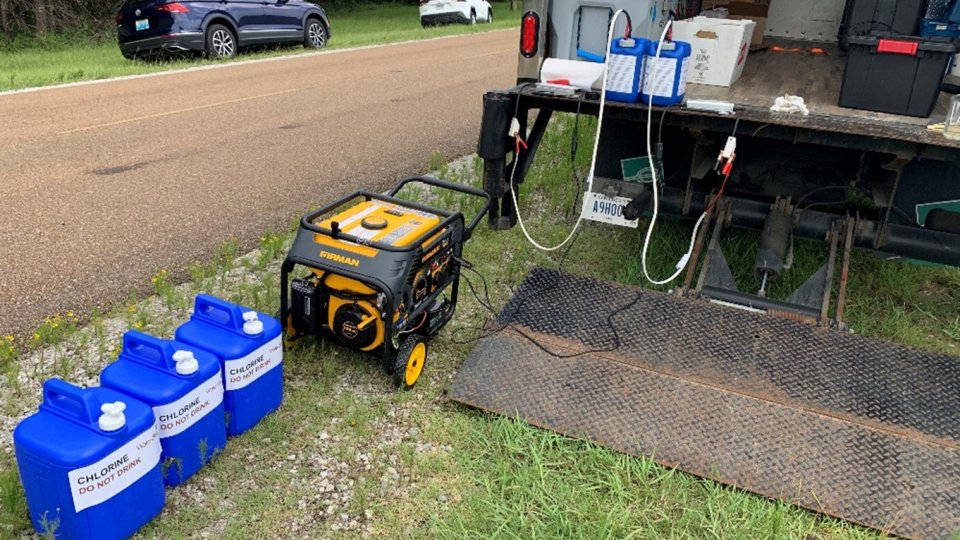
Making bleach at the Granada Lake Dam.
March 2023 - Vicksburg, MS
The levee relief wells near Vicksburg do not flow continuously, are much deeper and below the ground surface than those at Granada Lake Dam.
Treatment of these relief wells was similar to the Granada Lake Dam relief wells, except the WOW Cart bleach solution was also combined with the WOW Cart water treatment train to increase the free chlorine residual being put into contact with the well casing. The USACE oxalic acid mixing tank and pumps, rather than the WOW Cart bladder tank, were also used to streamline the operation. The goal was to treat 20 wells. Combining the WOW Cart treatment utilizing the USACE trailer enabled 32 wells to be rehabilitated. The operators also found the WOW Cart operation to be easier and safer than having to physically handle, open, and mix the multiple bags of oxalic acid. Eliminating the need for the oxalic acid also reduces the overall cost. Evaluation of the performance of the various treatment combinations is underway, including water quality and returning the necessary flows to the wells compared to their original design.
Integrating the WOW Cart into USACE Operations
Following the studies at Grenada Lake Dam and the Vicksburg levee relief wells, the USACE decided to integrate the WOW Cart into their Relief Well Rehabilitation Standard Operating Procedure replacing the oxalic acid with the WOW Cart. Two trailers are being built. One will be operated by the USACE Mississippi Valley District located in Vicksburg, MS. The second trailer and system will be developed by the USACE Engineer Research and Development Center to be deployed at another USACE District (TBD). The addition of chlorine infused water and bleach treatment for field design protocols helps improve the relief well risk management to dams and levees, which in turn reduces the cost, time, and manpower required to control relief well biofilm and corrosion. Establishing an integrated trailer for treatment will improve the operational process.
-
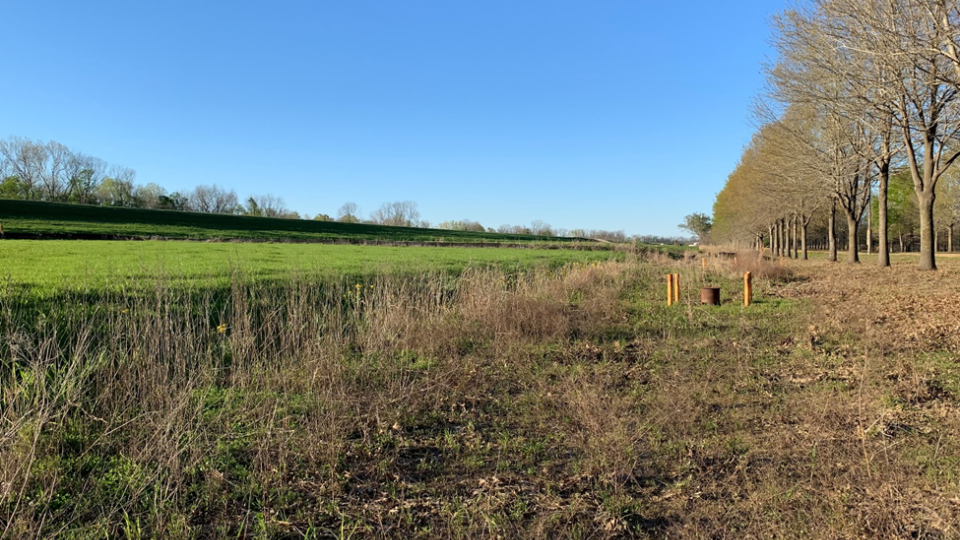
Mississippi River Levee relief wells near Vicksburg, MS.
-
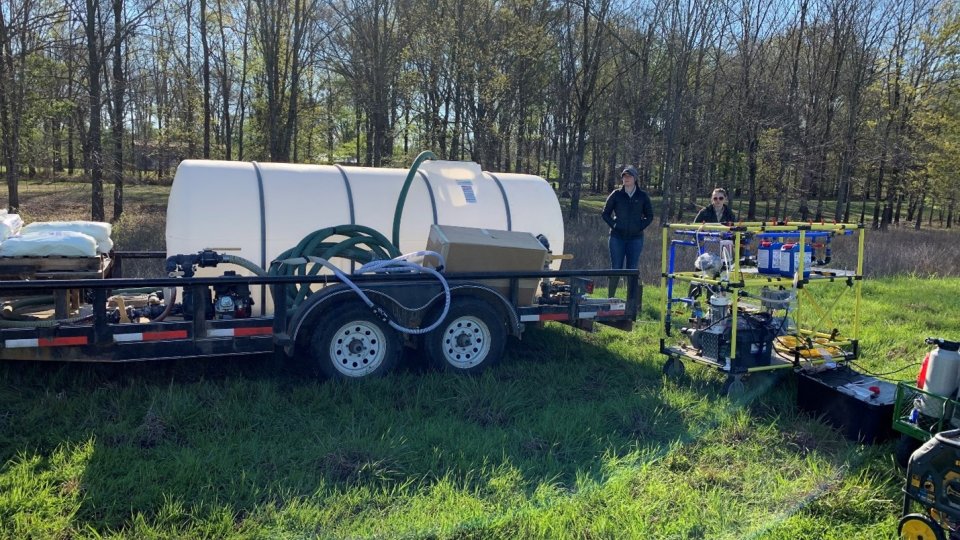
WOW Cart combined with the USACE trailer.
-
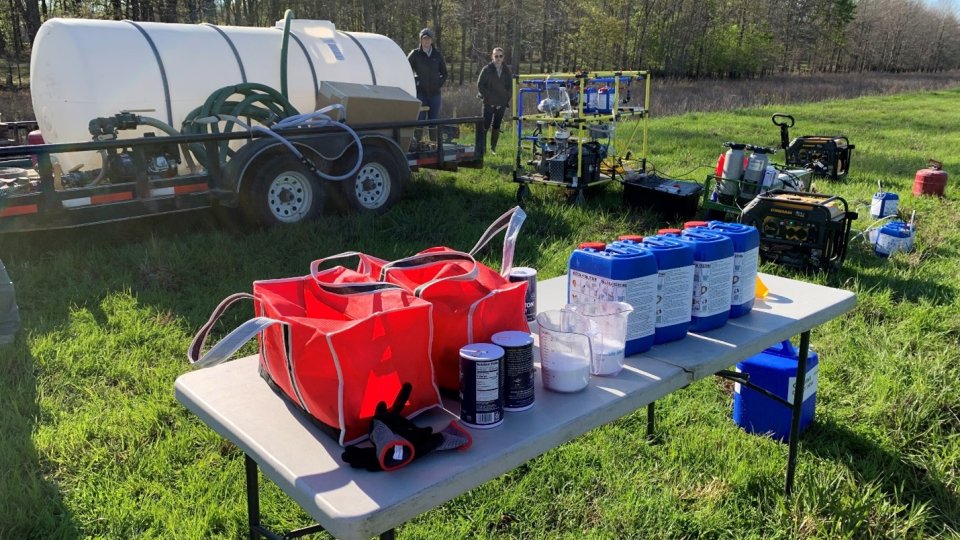
Making bleach at the levee near Vicksburg, with the combined operation of the USACE trailer and WOW Cart. The blue jugs on the table each contain an electric probe that turn the salt water in the jugs into bleach.
February 2024 - Mississippi River
The new trailer was evaluated in February 2024 along the Mississippi River approximately 30 miles north of Vicksburg, MS at the Magna Vista Levee. Thirty relief wells were decontaminated in about one day. Typically, no more than 20 are treated under the previous oxalic acid system. Following air lifting of the wells, various concentrations of free chlorine and well-volumes were pumped into the wells to try to determine the optimal volume and dosing to rehabilitate the wells. Some wells were further treated with an experimental UV light that was lowered into the well to address microbial contamination. Follow-up well flow and microbial testing will be conducted to optimize the decontamination protocol. Once finalized, it is expected that 20-30 wells per day will be able to be rehabilitated, thus reducing costs for the five-year treatment cycle for the relief wells.
WOW Cart Military Modifications
In 2023, the WOW Cart was modified to comply with ruggedized military specifications.
This version of the WOW Cart is being called the Deployable Resilient Installation water Purification System (DRIPS). Following a demonstration and training at Ft. Leonard Wood, MO in June 2023, the DRIPS was then deployed to the Letterkenny, PA Army Depot funded through the USACE Installation Technology Transfer Program.
-
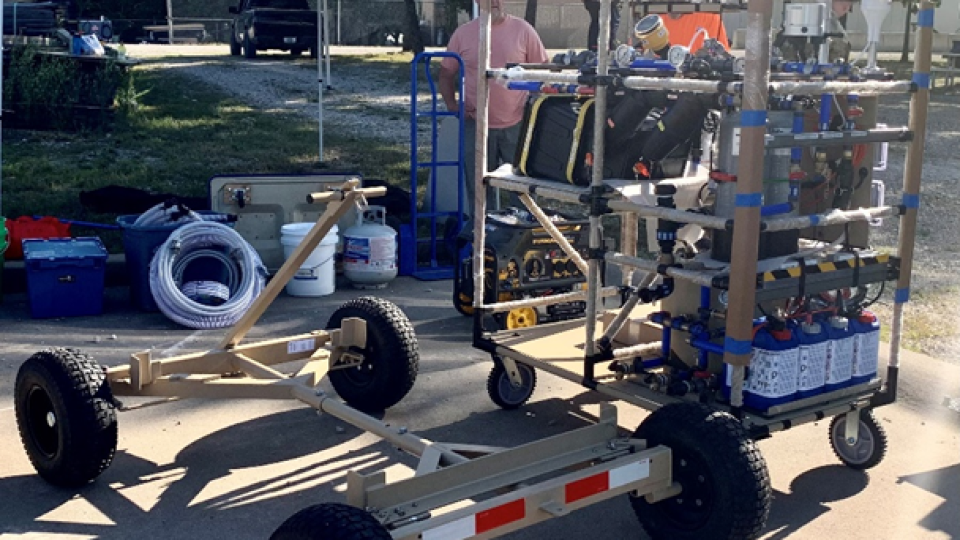
DRIPS Cart at Ft. Leonard Wood, MO with personal trailer (military version).
-
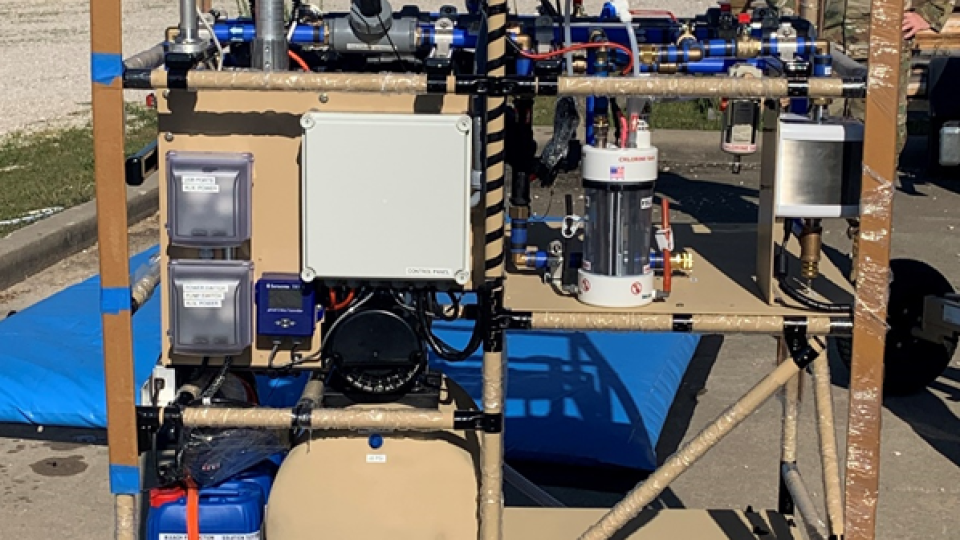
Ruggedized DRIPS Cart used at Ft. Leonard Wood, MO.
-
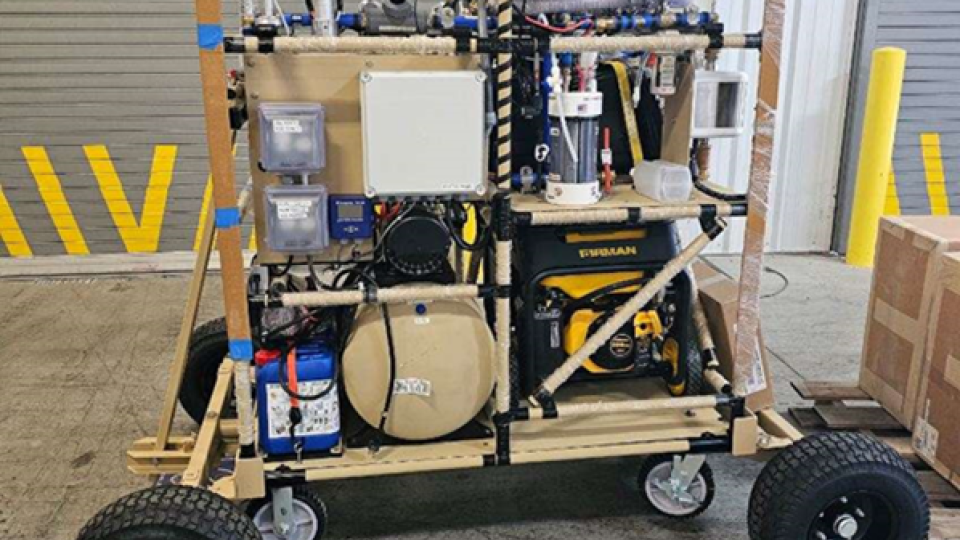
DRIPS Cart mounted on a personal trailer.
March 2024 - Testing Arctic Conditions (Ft. Wainwright, Alaska)
In March 2024, DRIPS was showcased inside a U.S. Northern Command prototyped Microgrid called the Modula S structure. The demonstration aimed to allow for integration of potable water production capability in an Arctic region to test processes, procedures, systems, strengthen relationships with mission partners, assess training readiness, and conduct experiments aligning with the U.S. Army and U.S. Northern Command's science and technology strategies in the Arctic.
Arctic forces are at risk of mission failure when purifying, storing, and distributing liquid water in the Arctic at high altitudes, seasonally changing and challenging terrain, and temperatures down to -65ο F, thus preventing sustainable support for forces in this environment.
The ruggedized Arctic DRIPS is envisioned to be a component in the full-scale logistic support function in extreme cold environments. It functioned as expected, despite having traveled and being stored in sub-freezing temperatures (-11ο F). In extreme cold climates, maintaining sealed thermal barriers, reliable power sources, and protection from the elements are imperative for mission assurance and maintaining fuel and water in its liquid state. The R-60 Ultra efficient Building Envelope is capable of sustaining at exterior temperatures of -65ο F to 127ο F. The Modula S protective exoskeleton and independent power grid is designed for deployment in arctic and desert environments. The DRIPS is well-suited for this application given its mobility and ability to operate via multiple energy sources with low consumable utilization. The Modula S system's passive building design principles ensured optimal performance of the DRIPS in the harsh arctic conditions, with a constant operating temperature of 60ο F despite exterior temperatures dropping to -14ο F the week of testing.
Partners included the U.S. Army 953rd Theater Petroleum Center, the North American Aerospace Defense Command and the International Cooperative Engagement Program for Polar Research, in coordination with the Office of Naval Research and the Polar Water and Wastewater working group initiatives. Local participants included the Alaska National Guard, Tribes, and law enforcement correctional officers.
June 2024 - Field Support (Ft. Barfoot, VA)
The Quartermaster Liquid Logistics Exercise is a two-week national exercise that occurred in June 2024 where fuel and water support are provided to U.S. Soldiers in the field. The ruggedized WOW Cart (DRIPS) was set up at a pond and began treating water within two hours. The next day, it was ordered to re-deploy on the other side of the lake with the other military Reverse Osmosis Water Purification Units. The DRIPS bladder tanks and system were drained and moved, producing water within three hours in the new location. Water testing by the U.S. Army showed no microbial contamination in the finished water which was drank by personnel.
Fall 2024 - Camp Shelby Joint Forces Training Center, MS
In Fall 2024, the USACE's Gray Water Treatment system was successfully integrated with DRIPS, which will be known as the Graywater Logistics Assured Defense Installation Advance Technology for Operational Resiliency (GLADIATOR) system.
Regional Demonstrations
EPA Region 7
A WOW Cart was deployed to EPA Region 7 for training staff and demonstrations to state drinking water personnel. Following a briefing to Regional staff by ORD, the WOW Cart was demonstrated at two different sites locally. Recommendations were made by Region 7 staff to modify the flow path in order to reduce the possibility of a cross-connection when changing the distribution location of finished water. Additional treatment devices are being investigated for use to treat highly contaminated raw water.
